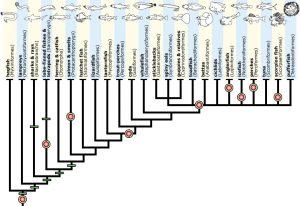
Phylogeny of fishes (diagram credit: evolution.berkeley.edu).
Phylogeny is the representation of evolutionary relationships, often displayed as a “tree” (i.e., branching diagram) where the most closely related organisms are connected by a node and more distantly related organisms have multiple steps back in the tree before they are connected. Nodes are often characterized by biogeographic events and evolutionary innovations.
In fishes, jawless fishes (such as hagfish and lampreys) are the most primitive, cartilaginous, and without paired fins; sharks and rays are cartilaginous with jaws and placoid denticles; and bony fish are the most diverse and derived fishes, with scales (see cycloid and ctenoid), swim bladders, and bony skeletons.
